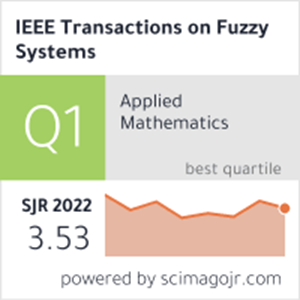Asynchronous Observer Design for Fuzzy Control of Nonlinear Semi-Markov Jump Singularly Perturbed Systems
IF 11.9
1区 计算机科学
Q1 COMPUTER SCIENCE, ARTIFICIAL INTELLIGENCE
引用次数: 0
Abstract
This article provides a novel framework for the concurrent development of asynchronous observers and controllers for discrete-time nonlinear semi-Markov jump singularly perturbed systems subjected to mismatched modes, states, and premise variables between controlled systems and observer-based controllers. Aiming at characterizing nonlinearity with parameter uncertainty, the interval type-2 (IT2) Takagi–Sugeno fuzzy technique is implemented in system modeling. Meanwhile, it is supposed that both observer and controller modes can just be acquired via a hidden Markov mode detector in the first attempt. Then, following the concept of nonparallel distribution compensation, the observer-based IT2 fuzzy asynchronous controllers are constructed with observers and controllers sharing the same fuzzy membership function but different from that in systems, which improves the designed flexibility. In accordance with semi-Markov kernel approach and the Lyapunov function contingent upon both system modes and sojourn times, sufficient criteria are established for the functioning of expected mode-dependent IT2 fuzzy observers and controllers such that the非线性半马尔可夫跳变奇摄动系统模糊控制的异步观测器设计
本文为被控系统和基于观测器的控制器之间存在模式、状态和前提变量不匹配的离散非线性半马尔可夫跳变奇摄动系统异步观测器和控制器的并发开发提供了一个新的框架。针对具有参数不确定性的非线性特性,将区间type-2 (IT2) Takagi-Sugeno模糊技术应用于系统建模。同时,假设观测器模式和控制器模式都可以在第一次尝试中通过隐马尔可夫模式检测器获得。然后,根据非并行分布补偿的概念,构造了基于观测器的IT2模糊异步控制器,观测器和控制器具有相同的模糊隶属度函数,但不同于系统中的模糊隶属度函数,提高了设计的灵活性。根据半马尔可夫核方法和取决于系统模态和逗留时间的李雅普诺夫函数,建立了期望模态相关的IT2模糊观测器和控制器功能的充分判据,从而保证了由被控系统和观测误差系统组成的非线性增广半马尔可夫跳变奇摄动系统的σ -均方稳定性。进一步从模糊处理的角度,加入符合模糊规则的参数和松弛矩阵,保证系统的稳定性,同时进一步降低条件的保守性。最后,给出了电路模型和比较实例,证明了所提技术的必要性和优越性。
本文章由计算机程序翻译,如有差异,请以英文原文为准。
求助全文
约1分钟内获得全文
求助全文
来源期刊

IEEE Transactions on Fuzzy Systems
工程技术-工程:电子与电气
CiteScore
20.50
自引率
13.40%
发文量
517
审稿时长
3.0 months
期刊介绍:
The IEEE Transactions on Fuzzy Systems is a scholarly journal that focuses on the theory, design, and application of fuzzy systems. It aims to publish high-quality technical papers that contribute significant technical knowledge and exploratory developments in the field of fuzzy systems. The journal particularly emphasizes engineering systems and scientific applications. In addition to research articles, the Transactions also includes a letters section featuring current information, comments, and rebuttals related to published papers.
 求助内容:
求助内容: 应助结果提醒方式:
应助结果提醒方式:


